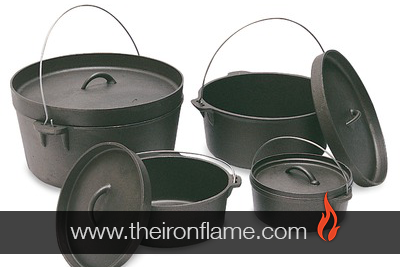
01 Apr How to Choose the Best Dutch Oven

How to Choose the Best Dutch Oven
Dutch Oven cooking has become more popular in recent years, but has been a way of cooking for decades. With the use of a Dutch Oven you can create delicious meals while camping or at home. Dutch Ovens come in a variety of sizes, are made by different manufactures, and have a variety of features. When choosing the perfect Dutch Oven for your family or your cooking style here are some of the things that you will want to consider:
- Brand: First you may want to consider the many different brands of Dutch Ovens available on the market today. Some of the Dutch Oven manufactures have been making Dutch Ovens for decades, while there are others that are recent to the Dutch Oven industry. You can get quality Dutch Ovens from many different manufactures, but you should do some research into the top brands you are considering to determine pros and cons of each. Look not only at the specifics of the Dutch Oven but also specifics about the company, their reputation, reviews, customer service, and even pricing.
- Price: When choosing a quality Dutch Oven it is important to know that you will be making a significant investment. Dutch Ovens can be costly, but are an investment in cooking and preparedness that will last a lifetime if well cared for. In fact, many Dutch Ovens are passed from one generation to the next.
- Material: Not all Dutch Ovens are made the same. Quality Dutch Ovens are made of cast iron steel. They should be heavy. Other Dutch Ovens may be made of aluminum. While they are still acceptable for cooking a variety of meals in, it is important to note that they will not season, heat, or cook as consistently as a cast iron Dutch Oven will. When looking for the best Dutch Ovens it is also important to check the thickness of the entire oven, or kettle, itself. When choosing a Dutch Oven you want one that is of good material and an even thickness.
- Size: Dutch Ovens come in a variety of different sizes. The most common sized range from eight inches in diameter to twenty-four inches in diameter. Dutch Ovens may also come in a variety of heights. The different sizes allow you to make larger or smaller meals, as well as allow you to combine sizes when cooking to create complete meals at once. Smaller Dutch Ovens are designed to stack on top of larger Dutch Ovens for ease of cooking a variety of different meal components at once. The most common size for a Dutch Oven is a twelve inch diameter and is designed to feed groups of six to ten people. When cooking a complete meal the main dish is most often placed in a twelve inch or larger Dutch Oven and then smaller Dutch Ovens containing the side dishes are placed on top of that. In fact, for a complete meal that includes dessert, you can cook solely in a variety of sized Dutch Ovens in one tower.
- Legs: One important feature to look for when choosing a Dutch Oven is whether or not it has legs. In order to use your Dutch Oven properly, it must have legs to keep it off the coals. Dutch Ovens that do not contain legs are designed for use inside of a conventional oven or use as a pot or kettle. Traditionally Dutch Ovens will have three legs spaced equally apart. They should be long enough to support the Dutch Oven above the charcoal briquettes that you will use as well as sturdy enough to support the Dutch Oven and not melt or break off when placed on top of another Dutch Oven during tower cooking. Choose Dutch Ovens with well build and well attached legs.
- Handles: Also knows as a bail, the addition of a wire handle or bail allows you to easily lift and move the Dutch Oven. Handles are designed to lie flat when placed on one side of the Dutch Oven and stand at approximately a forty-five degree when on the other side. This allows for storage of the handle when the Dutch Oven is not in use, but also keeps the handle at an easy to access position when in use. Things to look for to know if the Dutch Oven you choose has a quality handle is ease of movement from one side to the other and how it is attached to the Dutch Oven. It should be attached at molded areas not simply with rivets as the rivets will eventually fail and the handle will come off.
- Lid: To make a Dutch Oven effective in cooking the lid should have three primary components. First, the lid needs to have a lip or a rim all the way around it. The lip helps to keep the coals as well as the resulting ash on the top of during cooking as well as when the lid is lifted. This is important to keep the ash off of the food being cooked inside of the Dutch Oven. There should also be a handle built into the lid. This is not the same as the handle or bailthat goes over the entire Dutch Oven, but a smaller handle that is used to lift just the lid. The handle needs to be molded into the center of the lid so that it will last. Finally, the lid should be tight fitting to ensure proper cooking of food items inside the Dutch Oven.
Once you know the best Dutch Oven to choose you can take it home, season it, and begin cooking and enjoying Dutch Oven cooked meals.


No Comments